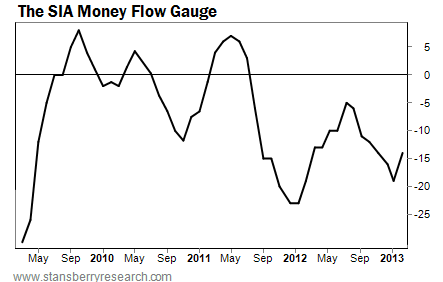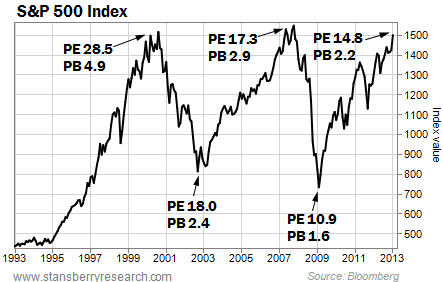 The stampede into stocks is about to begin.
The stampede into stocks is about to begin.
Investors have been in cash and bonds and generally on the sidelines for a long time.
But now, they’re beginning to plow into stocks.
While most of you consider this good news (as stock prices will surely move higher), I think it’s bad news.
Let me show you why…
Since the bear market of 2008 and 2009, fund inflows into stock-focused mutual funds have been weak to negative.
Just look at our Stansberry’s Investment Advisory money flow gauge, where we track the inflows to stock mutual funds in my newsletter each month.
When the line crosses above the “0” threshold, it means investors in the aggregate are pumping more dollars into these funds than they are withdrawing… When it’s stuck below “0” – as it has been since the middle of 2011 – investors (in the aggregate) are pulling their money out of equities.
Month after month, we’ve seen people taking money out of stocks.

Inflows into bond funds, meanwhile, have been tremendous. And as a result, bond prices have set new records – especially lower-quality, high-yielding “junk bonds.” There is no doubt that the Federal Reserve’s decision to massively manipulate interest rates lower by plowing $50 billion a month into bonds has created an epic bubble.
[ad#Google Adsense 336×280-IA]Exchange-traded funds (ETFs) have now amassed more than $30 billion in junk bonds.
Investors buy ETFs rather than directly buying bonds because they can do so faster and easier.
They believe (wrongly) that these ETFs offer them more liquidity.
They believe they will be able to sell if they need to.
They’re making a huge mistake.
The junk-bond market is the most accident-prone area of the capital markets. Liquidity can dry up overnight. Information on trading is opaque at best. And even bond prices themselves can be hard to find when the market is moving. If these funds were hit with redemptions, the market would simply freeze up. Prices would literally disappear. No bid. No buyers, anywhere.
Today, bonds held by these ETFs are already paying yields more than 2% lower than comparable bonds they don’t hold. That means, they’ve bid up the prices on the bonds they’ve been buying because there’s so little liquidity in that market. Average prices on junk bonds are now $105.60 – an all-time high.
I can’t stress this enough… investing other people’s money (what ETFs do) into high-yield junk bonds… when they’re trading at record-high prices… in a market where you’ve already outbid yourself by 200 basis points (two percentage points)… is crazy. That’s pretty much the most obvious bubble I’ve seen in my entire career. I don’t know when that bubble will pop, but I know it will. It will be a true disaster when it does. And the trouble might already be starting.
Capital flows began favoring stocks over bonds late last year for the first time since 2009. Since November, roughly $100 billion has flowed into stock mutual funds (irrespective of withdrawals), including nearly $20 billion last week – the third-largest inflow week on record. During the same 10-week period, only $35 billion flowed into bond mutual funds.
There’s no doubt that these new stock mutual fund inflows are pushing the stock market (particularly the large indexes) to new all-time highs. How do I know? About half of these inflows went directly into S&P 500 index funds. The S&P 500 is a market-cap-weighted index, which means the biggest stocks carry the most weight in the index.
You see, the S&P 500 was created by Standard and Poor’s, a credit ratings agency. It created the index to help sell rating services to the biggest companies in America. And so, it gave the most weight in the index to the companies that were the most likely to use its credit ratings to sell bonds to investors. The point is, the index wasn’t created to help individuals manage their money. That people use it to do so is, in my view, proof-positive of willful stupidity.
Investing in the index means most of your money will go into stocks that are already the biggest and most expensive… and more and more of your money will go into these stocks as other index investors continue to bid them higher and higher without any other consideration. It makes no sense.
And yet, about half the people buying mutual funds will only buy stocks this way. As these folks re-enter the equity markets, they will send stocks much higher. And because they do not understand the first thing about successfully investing in stocks… they will literally bid up the stocks that have already gone up the most.
I’ve been expecting stocks to go on a tear higher. It was inevitable, given the Federal Reserve’s suicidal monetary policies. Recently, legendary value investor Seth Klarman did a great job of explaining why the Fed’s policy is so dangerous. The quote below is from his annual letter to the investors in his Baupost hedge fund:
[Fed Chairman Ben] Bernanke and Draghi [the head of the European Central Bank] seem intent on buying back bonds indefinitely, whether or not their actions deliver an economic recovery and in spite of any unpleasant side effects. It is clear after four years and counting that their efforts have not delivered as predicted. Only a zealot would continue on with a plan that is not working and, in defiance of reason, massively expand it…
The greatest danger? How swiftly market participants have come to accept some actions as normal. What could possibly go wrong? Well, just about everything: markets distorted, future returns diminished, moral hazard snuffed out, new bubbles inflating, caution abandoned, inflation unleashed. When investors come to believe that downside tail risk has been extinguished, it emboldens them to pay higher prices, thereby accepting more risk with less return. [Emphasis added.]
Look at the chart below carefully. It shows you the core valuation metrics of the S&P 500 at the various recent highs and lows.

If you’re new to investing in stocks, don’t let this chart scare or intimidate you. It doesn’t indicate that stocks are about to crash. It simply gives you a medium-term overview of real prices.
One of the hardest things for most investors to grasp is that nominal prices, whether for individual stocks or indexes (like the S&P 500) are meaningless. Over time, inflation will push nominal prices higher. So will real economic growth and increases to earnings. Thus, the only way to actually compare values over time is by using metrics like price-to-earnings (PE) or price-to-book-value (PB) ratios. Those numbers are displayed on this chart.
Back in 2000, stocks were in a huge bubble (just as I believe bonds are in a huge bubble today). They traded at almost 30 times earnings and for nearly five times book value. By the lows of 2009, those metrics were cut by roughly 75%. Stocks were trading at just 10 times earnings and a little more than one-and-a-half times book.
Simple question: Do you think you’re more likely to do well buying a stock at 30 times earnings or at 10?
If you don’t know the answer immediately, just think of it this way. Assume you were to buy the entire company. If you did, you could keep all the earnings yourself. If you bought in 2000, it would have taken you 30 years to recoup your investment, assuming earnings remained the same. By 2009, it would have only taken 10 years to recoup your investment, assuming earnings remained the same. See why it’s important to buy stocks when they’re cheap?
Today, the S&P 500 is basically at the same level it was in 2000 and at the top in 2007. Does that mean stocks are dangerously expensive? I don’t think so. As you can see, stocks are trading for about 15 times earnings right now.
With the Fed pursuing its manic money printing and manipulating the bond market in this extreme way, I think Seth Klarman is right… Investors will come to believe that this magical money printing is going to solve all our problems. They will become more and more willing to pay higher prices for stocks. I think the inflows we’re seeing right now are a sign of much bigger inflows to come. I believe the bubble in the bond market will spill over into the stock market in 2013.
Just understand… this will not end well. When the money printing finally stops, there will be hell to pay. The crashes of 2000/2001 and 2008/2009 will seem like minor blips. After all, by the time this thing really blows up, we could have record-setting bubbles in both stocks and corporate bonds.
But… for the kind of crash I expect to materialize, we’re going to have a big run up in stocks first. Right now, they’re not even overvalued. They’re just not cheap anymore. On a valuation basis, I think stocks could easily double from here before we reach the final top I expect.
What does this mean for you? Well, I don’t think it’s time to sell. But I sure hope you’ve made some good investments already, as it’s going to become extremely difficult to find reasonable values.
Most of you reading this will not heed this warning. But I believe it’s my job to tell you what I’d want to know if our roles were reversed. So here it is…
At some point over the next 12-18 months, stocks will tear higher. Much higher. You’ll be tempted to try and make a killing by buying stocks on margin or, even worse, buying naked call options… or perhaps putting too much money into the riskiest stocks you can find.
Don’t do it. The foundations of this bull market are pure air. It will not last. If you’re buying all the way up, you will get burned. For now, watch your trailing stops and enjoy the ride. But don’t mistake this inflated market for a new, permanent prosperity. Others will, you can count on it. Don’t follow them off the cliff.
Regards,
Porter Stansberry
[ad#stansberry-ps]
Source: Growth Stock Wire
